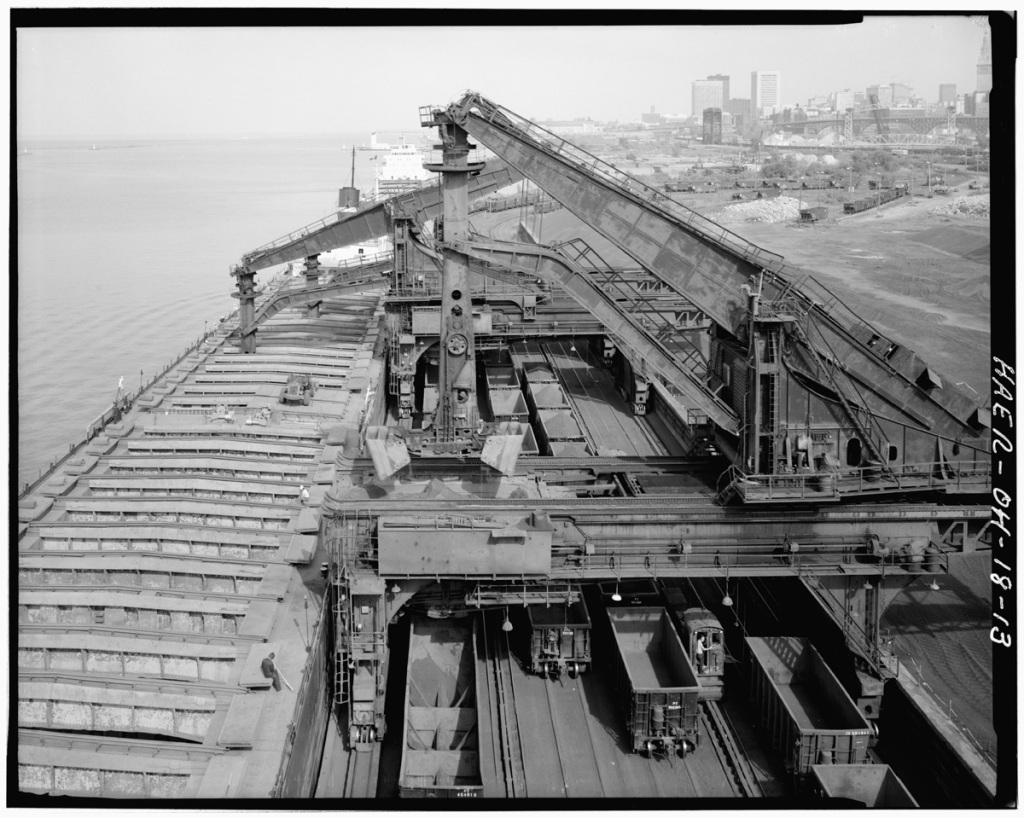
Another in a series of graphics work which doesn’t make the cut, but shouldn’t be sent to the bit bucket.

Another in a series of graphics work which doesn’t make the cut, but shouldn’t be sent to the bit bucket.

The Hulett Automatic Ore Unloaders once saw wide usage along the Great Lakes unloading bulk ore ships. The Huletts were electrically powered on two parallel tracks along the docks, ordinarily with four railroad tracks in between. A vertical column with a large scoop bucket on the end houses the machine’s operator stationed above the bucket for maximum cargo visibility. The Operator could spin the beam at any angle scooping up to 10 tons of ore per run dumping the load into a moving receiving hopper which ran between the main girders dumping the load into a waiting railroad car.
I vaguely remember seeing the Huletts on Whiskey Island in Cleveland, Ohio when I was a young boy – they were demolished in 2000 after standing idle since 1992 after self-unloading ore ships became the standard on the Great Lakes. So seeing a video of them in operation is amazing: I didn’t realize how big the ore ships were, so the when they strap a front loader to the Hulett bucket and drop it into the ore hold I was dumbfounded.
Below is a video from 1999 from the engine of Amtrak train #44 going under the Huletts on Whiskey Island:
Below is a series of photos from the Library of Congres Pennsylvania Railway Ore Dock, Lake Erie at Whiskey Island collection at the American Memory collection.

![]()
Just another accident during project crunch-time.
Kodak has a new installation at the George Eastman House through September 16th entitled See: Untold Stories a survey of photography from the earliest efforts in the 19th century to the most recent techniques and aesthetics. Supporting this installation they have created six videos highlighting six different photographic processes: the Collodion Process, the Albumen Print, the Woodburytype, the Daguerreotype, the Platinum Print, the Gelatin Silver Print. The first four are below with a special extra featuring the Tintype process.
As a former resident of Cincinnati, this makes me happy and hopeful that the Queen City will revitalize – Addressing ‘missing middle’ housing in the Queen City:
Cincinnati’s urban neighborhoods are at a tipping point. The city has lost 40 percent of its population since 1950, leaving suburban densities in the city’s formerly urban neighborhoods. Many residential buildings and lots sit vacant or poorly maintained, with over 10,000 historically contributing units in need of renovation. Neighborhood main streets have withered due to lack of people, competition from nearby big box stores, and bad thoroughfare design that speeds cars and potential customers through these neighborhoods rather than to them. In addition, jobs followed the people to the suburbs.
via Addressing ‘missing middle’ housing in the Queen City | Better! Cities & Towns Online.
Cincinnati is embarking on a form-based zoning code revision with a review draft this fall. Here are a bunch of documents pertaining to the ongoing study and a preview of the different draft zoning transepts.
My favorite buildings in Chicago are by Bertrand Goldberg, architect of slightly eccentric buildings throughout the Windy City including the Marina City Towers, River City and Prentice Women’s Hospital on Northwestern University’s Medical Campus in the heart of Chicago. A few years ago the university moved out of the building and it has sat vacant. Northwestern University has recently made rumblings about demolishing the building to make way for a newer – and probably more bland – building. The National Trust for Historic Preservation has a Save Prentice Petition asking you to “Show Prentice Some Love.”
*Q: Excuse me? A: These previously published entries have been updated with new information recently. You can find past updates here.
Fanning out from its headquarters bounded by Vesey and Murray Streets, next to the World Financial Center and a block northwest of ever-rising ground zero, there is now a kind of Goldman village anchored by Goldman Alley, as the locals call the public passageway between Vesey and Murray that’s shielded by a tilted glass canopy.
via It’s a Goldman World in Battery Park City – NYTimes.com.

Readers, tell me: How did you spend your leap second?
Well, looks like the Leap Second of 2012 crashed part of the Internet:
Yesterday’s leap second killed half the Internet, including Pirate Bay, Reddit, LinkedIn, Gawker Media and a host of other sites. Even an airline. Any Linux user processes that depends on kernel threads had a high chance of failing. That includes MySQL and many Java servers like webapps, Hadoop, Cassandra, etc. The symptom was the user process spinning at 100% CPU even after being restarted. A quick fix seems to be setting the system clock which apparently resets the bad state in the kernel (we hope).
The underlying cause is something about how the kernel handled the extra second broke the futex locks used by threaded processes. Here’s a very detailed analysis on the failing code but I’m not sure it’s correct. According to this analysis the bug was introduced in 2008, then fixed in March 2012. But it may be the March fix is part of the problem. Patch here. OTOH most of the systems that failed will be running kernels older than March so the problem must go further back. Time is hard, let’s go shopping.